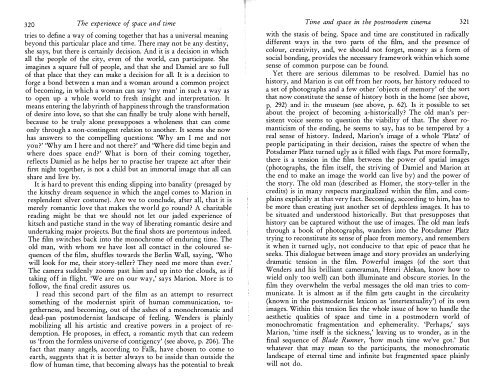The Condition of Postmodernity 13 - autonomous learning
The Condition of Postmodernity 13 - autonomous learning
The Condition of Postmodernity 13 - autonomous learning
Create successful ePaper yourself
Turn your PDF publications into a flip-book with our unique Google optimized e-Paper software.
320 <strong>The</strong> experience <strong>of</strong> space and timetries to define a way <strong>of</strong> coming together that has a universal meaningbeyond this particular plac , e and ti , e, <strong>The</strong>re I1a'y not b, e ,any ,desti y,she says, but there is certamly declSlon, And It IS a declSl r: m whIchall the people <strong>of</strong> the city, even <strong>of</strong> the world, can pa tlClpate, Sheimagines a square full <strong>of</strong> people, and that she and Damiel are so full<strong>of</strong> that place that they can make a decision for all. It is a decisio r: t<strong>of</strong>orge a bond between a man and a woman around a common project<strong>of</strong> becoming, in which a woman can say 'my man' in such a way asto open up a whole world to fresh insight and interpretation. , Itmeans entering the labyrinth <strong>of</strong> happiness through the tran formatlon<strong>of</strong> desire into love, so that she can finally be truly alone wIth herself,because to be truly alone presupposes a wholeness that can comeonly through a non-contingent relation to another. It seems she nowhas answers to the compelling questions: 'Why am I me and notyou?' 'Why am I here and not there?' and 'Where did time begin andwhere does space end?' What is born <strong>of</strong> their coming togethe : ,reflects Damiel as he helps her to practise her trapeze act after theIrfirst night together, is not a child but an immortal image that all canshare and live by.It is hard to prevent this ending slipping into banality (presaged bythe kitschy dream sequence in which the angel comes to Marion inresplendent silver costume). Are we to conclude, after all, that it ismerely romantic love that makes the world go round? A charitablereading might be that we should not let our jaded experience <strong>of</strong>kitsch and pastiche stand in the way <strong>of</strong> liberating romantic desire andundertaking major projects. But the final shots are portentous indeed.<strong>The</strong> film switches back into the monochrome <strong>of</strong> enduring time. <strong>The</strong>old man, with whom we have lost all contact in the coloured sequences<strong>of</strong> the film, shuffles towards the Berlin Wall, saying, 'Whowill look for me, their story-teller? <strong>The</strong>y need me more than ever.'<strong>The</strong> camera suddenly zooms past him and up into the clouds, as iftaking <strong>of</strong>f in flight. 'We are on our way,' says Marion. More is t<strong>of</strong>ollow, the final credit assures us.I read this second part <strong>of</strong> the film as an attempt to resurrectsomething <strong>of</strong> the modernist spirit <strong>of</strong> human communication, togetherness,and becoming, out <strong>of</strong> the ashes <strong>of</strong> a monochromatic anddead-pan postmodernist landscape <strong>of</strong> feeling. Wenders is plainlymobilizing all his artistic and creative powers in a project <strong>of</strong> redemption.He proposes, in effect, a romantic myth that can redeemus 'from the formless universe <strong>of</strong> contigency' (see above, p. 206). <strong>The</strong>fact that many angels, according to Falk, have chosen to come toearth, suggests that it is better always to be inside than outside theflow <strong>of</strong> human time, that becoming always has the potential to breakTime and space in the postmodem cinema 321with the stasis <strong>of</strong> being. Space and time are constituted in radicallydifferent ways in the two parts <strong>of</strong> the film, and the presence <strong>of</strong>colour, creativity, and, we should not forget, money as a form <strong>of</strong>social bonding, provides the necessary framework within which somesense <strong>of</strong> common purpose can be found.Yet there are serious dilemmas to be resolved. Damiel has nohistory, and Marion is cut <strong>of</strong>f from her roots, her history reduced toa set <strong>of</strong> photographs and a few other 'objects <strong>of</strong> memory' <strong>of</strong> the sortthat now constitute the sense <strong>of</strong> history both in the home (see above,p. 292) and in the museum (see above, p. 62). Is it possible to setabout the project <strong>of</strong> becoming a-historically? <strong>The</strong> old man's persistentvoice seems to question the viability <strong>of</strong> that. <strong>The</strong> sheer romanticism<strong>of</strong> the ending, he seems to say, has to be tempered by areal sense <strong>of</strong> history. Indeed, Marion's image <strong>of</strong> a whole 'Platz' <strong>of</strong>people participating in their decision, raises the spectre <strong>of</strong> when thePotsdamer Platz turned ugly as it filled with flags. Put more formally,there is a tension in the film between the power <strong>of</strong> spatial images(photographs, the film itself, the striving <strong>of</strong> Damiel and Marion atthe end to make an image the world can live by) and the power <strong>of</strong>the story. <strong>The</strong> old man (described as Homer, the story-teller in thecredits) is in many respects marginalized within the film, and complainsexplicitly at that very fact. Becoming, according to him, has tobe more than creating just another set <strong>of</strong> depth less images. It has tobe situated and understood historically. But that presupposes thathistory can be captured without the use <strong>of</strong> images. <strong>The</strong> old man leafsthrough a book <strong>of</strong> photographs, wanders into the Pots darner Platztrying to reconstitute its sense <strong>of</strong> place from memory, and remembersit when it turned ugly, not conducive to that epic <strong>of</strong> peace that heseeks. This dialogue between image and story provides an underlyingdramatic tension in the film. Powerful images (<strong>of</strong> the sort thatWenders and his brilliant cameraman, Henri Alekan, know how towield only too well) can both illuminate and obscure stories. In thefilm they overwhelm the verbal messages the old man tries to communicate.It is almost as if the film gets caught in the circularity(known in the postmodernist lexicon as 'intertextuality') <strong>of</strong> its ownimages. Within this tension lies the whole issue <strong>of</strong> how to handle theaesthetic qualities <strong>of</strong> space and time in a postmodern world <strong>of</strong>monochromatic fragmentation and ephemerality. 'Perhaps,' saysMarion, 'time itself is the sickness,' leaving us to wonder, as in thefinal sequence <strong>of</strong> Blade Runner, 'how much time we've got,' Butwhatever that may mean to the participants, the monochromaticlandscape <strong>of</strong> eternal time and infinite but fragmented space plainlywill not do.
















